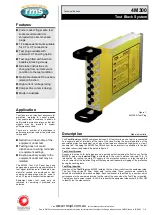
Visit
www.rmspl.com.au
for the latest product information.
Due to RMS continuous product improvement policy this information is subject to change without notice. 4M300/Issue K 10/08/21 - 2/6
RECOMMENDED WIRING LAYOUT
It is recommended that the Test Block is always wired with
connections to the protective relay or scheme made to the EVEN
numbered equipment side terminals. Connections to other
equipment, e.g. CT’s , VT’s & DC supplies, should be made to the
ODD numbered live side terminals on the Test Block. This ensures
that when the Test Plug is used, the BLACK sockets of the Test
Plug are the isolated relay circuits & the YELLOW sockets on the
Test Plug are connected to the potentially live supplies as shown in
figure 8.
Test equipment can be connected to the relay or scheme using the
BLACK sockets in the Test Plug, & operation of contacts can be
monitored. When using the 4M300-B Test Block, the DC supply
may be used during testing by linking across sockets 13/14 &
15/16 of the Test Plug.
Operation
CT SHORTING
– MANUAL
(External)
It is essential that the sockets of the 4M320 Multi-Finger Test Plug
which correspond to the current transformer (CT), secondary
windings are linked prior to the test plug being inserted into the test
block. This ensures that the current transformer secondary
windings are not open circuited when they are isolated from the
protection relay scheme.
This may be achieved using external shorting links to ensure that
the CT secondary windings are short circuited before they are
disconnected from the protection relay or scheme, thereby
avoiding dangerously high voltages.
The continuity of the shorting plug / wire links & their state of
insulation should be checked prior to into the 4M300 test block.
CT SHORTING
– AUTOMATIC
(Internal)
The 4M320 may be ordered with internal CT shorting links fitted to
pre-designated positions as follows:
4M320-B
Internal links between terminals 21-23-25-27
Refer figure 8
Where these 4M320 test plug versions are employed it is essential
that the CT circuits are wired to the 4M300 test block in the
matching positions.
To Reiterate: The 4M320 requires the
USER
to ensure that the
necessary shorting links - manual or automatic
– are
fitted prior to plugging into the 4M300 test block.
TEST LEAD INSERTION
Before use the insulation of the flying leads should be visibly
checked for damage.
Flexible banana test leads with shrouded plugs are recommended
for operator safety. 2.5mm
2
multi-strand wire with PVC insulation is
recommended for adequate current rating and flexibility.
TEST PLUG INSERTION
To avoid high voltage shock hazard external CT circuits must NOT
be open circuited. Shorting links must be in position BEFORE test
plug insertion.
Insertion of the 4M320 connects the live side circuits to the
YELLOW test sockets on the front panel. The equipment side
circuits are connected to the BLACK test sockets on the front
panel. Each test socket is identified by a number, which
corresponds to the numbered terminal on the rear of the case
when the Test Plug is inserted.
FINGER SAFE TEST SOCKETS
BLACK
- even numbered
- equipment side sockets
YELLOW
- odd numbered
- live side sockets
Figure 2: Close up view of the ‘finger safe’ test plug sockets that
accept standard 4mm shrouded test plugs
!
























